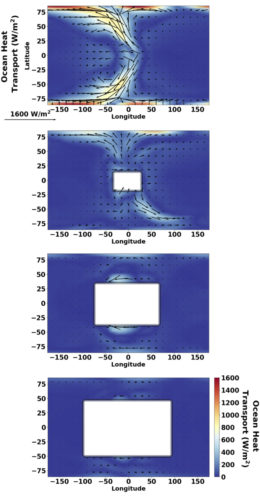Which habitable-zone planets can actually support life? A recent study uses a nearby planet — Proxima Centauri b — to examine how the presence and size of a land mass impacts the habitability of an ocean world.
A Target for Potential Life
In our galaxy, roughly 80% of stars are cool, dim M dwarfs — and one in six of these is thought to host an Earth-sized planet in its habitable zone. But being in a star’s habitable zone doesn’t guarantee a planet’s habitability! M-dwarf habitable-zone planets present valuable targets for observations and models to better understand which of these worlds can support life.

Artist’s impression of a cold, tidally-locked planet. Ice covers much of the planet’s surface, but the point directly facing the planet’s host star remains ice-free. [NASA/JPL-Caltech]
Do continents get in the way of this heat transport? And how do land masses affect the circulation of nutrients in the ocean, critical for sustaining ocean-based photosynthetic life? A new study explores the particular case of a tidally locked ocean planet with a continent — and it uses the nearby Proxima Centauri b as a model to do so.
Modeling a Nearby World
At just 4.2 light-years away, Proxima b is the closest known exoplanet and presents an excellent target for future follow-up observations. This habitable-zone M-dwarf planet is probably tidally locked, and estimates of its density have led to speculation that the planet is covered in a large ocean.

Ocean heat transport in the authors’ models for varying continent size; from top to bottom, continents (noted as the white rectangle in the figure) cover 0%, 4%, 22%, and 39% of the planet surface. Continents at the substellar point inhibit ocean heat transport. [Adapted from Salazar et al. 2020]
Salazar and collaborators placed a continent at the point on the planet closest to the star — because land masses are thought to migrate to the planet–star axis over time — and tested a range of continent sizes, covering from 0 to 40% of the total planet surface.
Promising Outcomes
The authors find that the presence of a continent decreases how efficiently heat and nutrients are transported from the dayside to the nightside of the planet — the larger the continent, the less efficient the transport. Nonetheless, in all cases, an ice-free ocean is maintained on the planetary dayside, and nutrients are circulated and delivered to the layer of the ocean where photosynthesis is viable, providing ideal conditions for photosynthetic marine life.
This work suggests that the presence of both a dynamic ocean and continents won’t decrease the habitability prospects of tidally locked planets like Proxima b. This is good news as we prepare for future observations with the James Webb Space Telescope, which may provide further insight into this nearby, potentially habitable world and others like it.
Citation
“The Effect of Substellar Continent Size on Ocean Dynamics of Proxima Centauri b,” Andrea M. Salazar et al 2020 ApJL 896 L16. doi:10.3847/2041-8213/ab94c1


1 Comment
Pingback: From AAS NOVA: “The Impact of Land on an Ocean World’s Habitability” | sciencesprings